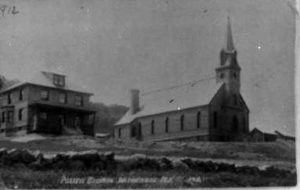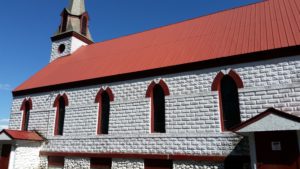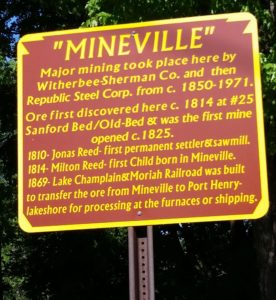Andebit et beaqui corendit, ut quostes esciendion re dit ad et prae parion es quia quas alibus sam, omnim faciden ducipidiat arum autem nobis enis es voat

18: The Churches of Mineville and Port Henry
Reflections of Immigrant Heritage
Listen to the Site 18 Iron Story Narration

The boom in iron trade first drew Irish settlers in the 1840. The Irish essentially witnessed the birth of Moriah and soon constituted most of the town. “By the time the second wave of expansion occurred, in the 1890s and early 1900s, the Irish were firmly established and remained a class apart from their newly arrived fellow Catholics,” writes historian Valerie Rosenquist.
The Irish who remained through the various mine closures did so because their jobs were more dependable than those of the men forced to move with the mines. Many second-generation Irish became merchants or service people in the expanding business center of Port Henry—where the wealthy mine owners and managers lived. The Irish played out this competition between other classes and immigrant groups most clearly in the establishment of churches and practice of their Catholic faith. The first church was St. Patrick’s in Port Henry, dedicated in 1852. A second Catholic church was built in 1870 in Mineville, Sts. Peter and Paul. Previously, Mineville Catholics had to travel the seven miles down the mountain to Port Henry for service, or sporadically hold mass in their homes.

Once Mineville had their own church, a sense of rivalry grew between the two Catholic churches. “It is on record that in every collection made at Port Henry, the miners on the mountain waited for the announcement of its total in order to make theirs a few dollars better,” writes Catholic Rev John Talbot Smith, who traveled through the area in the early 1880s. The difference in style and wealth of the two churches can be seen in the descriptions of the actual church buildings constructed. Smith glowingly describes St. Patrick’s in Port Henry: “There is no other to match it in the diocese, perhaps not in the state, for the quantities of beauty and fitness.” In contrast, he describes the Mineville church as “a neat brick church capable of holding five or six hundred souls.”
As competitive as the Irish Catholics of the two towns were with each other, the Mineville Irish quickly established their superiority over the newly arrived immigrants. One way they did this was by controlling their names. When the newcomers, mostly from Southern and Eastern Europe, arrived in the 1890s, the Irish could not pronounce their names, so they changed them. Wolanichevicz became Whalen. Kazlauskas became Kazlo. Podrezques became Podres. Mundi (Hungarian) became Mandy. Waservicaius became Savage. Dragungs became Dragoon. At the Mineville church, the Irish established a system of pew rentals that most newcomers could not afford.
 One story goes that Italian workers were told by their Irish foremen that they had to have their own equipment to work. They were poor and couldn’t afford the equipment, so the foreman said they could rent equipment from the company. They were to pay him the rent money. The company, however, did provide mining equipment.
One story goes that Italian workers were told by their Irish foremen that they had to have their own equipment to work. They were poor and couldn’t afford the equipment, so the foreman said they could rent equipment from the company. They were to pay him the rent money. The company, however, did provide mining equipment.
Most Eastern Europeans lived on Wasson Street. Mine workers were expected to surrender some control over their daily lives. Living in company-built housing, receiving goods from the company stores, and cared for in the company hospital, workers recognized the company as central to their lives.
The Poles—sensing hostility from the Irish and a want to maintain their own identity—held their masses in a defunct Hungarian Pentecost church until their church was built: St. Michael’s Roman Catholic Church and Rectory, built around 1910. The church is constructed of concrete block, with Gothic detailing, including a pointed-arch stained-glass windows and a spired bell tower.
The church’s crucial role is exemplified by the tenure of Father Stephen Wojciechowski at St. Michael’s Church (1927-1968). He helped people find jobs, lent money and influenced the local bank, acted as make-shift counsel and translator in legal matters, stressed the role of authority in word as well as in deed and emphasized discipline and pride in one’s ethnicity.
Travel Tools
St. Michael’s Church, built in 1910 for the Polish Catholic community, will be on your left, at 40 Wasson Street. You’ll also see many more concrete homes built by Witherbee, Sherman along Wasson Street. Stay on Wasson Street, go straight at the intersection with Main Street. Wasson Street now becomes Joyce Road.
CLICK TO VIEW SITE NINETEEN
First-Hand Account
Churches played an important role in mining society: “The priests assigned to the various parishes fulfilled expectations. Sts. Peter and Paul in Mineville retained its role as Mother Church for both Mineville and Witherbee. The Port Henry parish still held mostly Irish, with some Italian and Polish families. When the Eastern Europeans clamored for their own priest and parish, the bishop responded by allowing the establishment of a Polish Church, St. Michael’s, in 1910…. The Catholic Church joined with Witherbee-Sherman to demand loyalty and to help foster the sense of community. It served as one of the permanent authorities of the town, and that authority changed as the ethnic composition varied. Irish Catholics had arrived during the nineteenth century; the twentieth century arrivals included Italians, Poles, Lithuanians, French, Spanish, and Austrio-Hungarians. These new Catholics demanded (or were thought to require) different functions from their Church. They expected and received more direct intervention from the priest in non-religious aspects of their lives than had the Irish.” – Valerie Rosenquist, The Iron Ore Eaters


